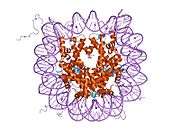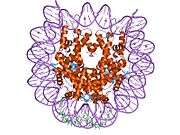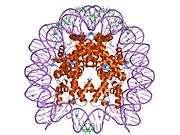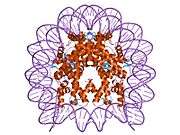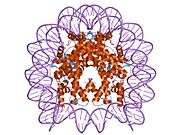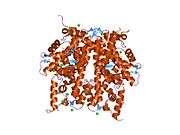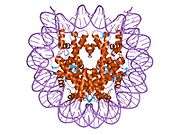H2AFJ
| H2A histone family, member J | |||||||||||||
|---|---|---|---|---|---|---|---|---|---|---|---|---|---|
|
PDB rendering based on 1aoi. | |||||||||||||
| |||||||||||||
| Identifiers | |||||||||||||
| Symbols | H2AFJ ; H2AJ | ||||||||||||
| External IDs | MGI: 3606192 HomoloGene: 128575 GeneCards: H2AFJ Gene | ||||||||||||
| |||||||||||||
| Orthologs | |||||||||||||
| Species | Human | Mouse | |||||||||||
| Entrez | 55766 | 232440 | |||||||||||
| Ensembl | ENSG00000246705 | ENSMUSG00000060032 | |||||||||||
| UniProt | Q9BTM1 | Q8R1M2 | |||||||||||
| RefSeq (mRNA) | NM_018267 | NM_177688 | |||||||||||
| RefSeq (protein) | NP_808760 | NP_808356 | |||||||||||
| Location (UCSC) |
Chr 12: 14.77 – 14.78 Mb |
Chr 6: 136.81 – 136.81 Mb | |||||||||||
| PubMed search | |||||||||||||
Histone H2A.J is a protein that in humans is encoded by the H2AFJ gene.[1]
Histones are basic nuclear proteins that are responsible for the nucleosome structure of the chromosomal fiber in eukaryotes. Nucleosomes consist of approximately 146 bp of DNA wrapped around a histone octamer composed of pairs of each of the four core histones (H2A, H2B, H3, and H4). The chromatin fiber is further compacted through the interaction of a linker histone, H1, with the DNA between the nucleosomes to form higher order chromatin structures. This gene is located on chromosome 12 and encodes a variant H2A histone. The protein is divergent at the C-terminus compared to the consensus H2A histone family member.[1]
References
Further reading
- Kimura K, Wakamatsu A, Suzuki Y, et al. (2006). "Diversification of transcriptional modulation: large-scale identification and characterization of putative alternative promoters of human genes.". Genome Res. 16 (1): 55–65. doi:10.1101/gr.4039406. PMC 1356129. PMID 16344560.
- Ota T, Suzuki Y, Nishikawa T, et al. (2004). "Complete sequencing and characterization of 21,243 full-length human cDNAs.". Nat. Genet. 36 (1): 40–5. doi:10.1038/ng1285. PMID 14702039.
- Lusic M, Marcello A, Cereseto A, Giacca M (2004). "Regulation of HIV-1 gene expression by histone acetylation and factor recruitment at the LTR promoter.". EMBO J. 22 (24): 6550–61. doi:10.1093/emboj/cdg631. PMC 291826. PMID 14657027.
- Strausberg RL, Feingold EA, Grouse LH, et al. (2003). "Generation and initial analysis of more than 15,000 full-length human and mouse cDNA sequences.". Proc. Natl. Acad. Sci. U.S.A. 99 (26): 16899–903. doi:10.1073/pnas.242603899. PMC 139241. PMID 12477932.
- Deng L, Wang D, de la Fuente C, et al. (2001). "Enhancement of the p300 HAT activity by HIV-1 Tat on chromatin DNA.". Virology 289 (2): 312–26. doi:10.1006/viro.2001.1129. PMID 11689053.
- Chadwick BP, Willard HF (2001). "Histone H2A variants and the inactive X chromosome: identification of a second macroH2A variant.". Hum. Mol. Genet. 10 (10): 1101–13. doi:10.1093/hmg/10.10.1101. PMID 11331621.
- Deng L, de la Fuente C, Fu P, et al. (2001). "Acetylation of HIV-1 Tat by CBP/P300 increases transcription of integrated HIV-1 genome and enhances binding to core histones.". Virology 277 (2): 278–95. doi:10.1006/viro.2000.0593. PMID 11080476.
- El Kharroubi A, Piras G, Zensen R, Martin MA (1998). "Transcriptional activation of the integrated chromatin-associated human immunodeficiency virus type 1 promoter.". Mol. Cell. Biol. 18 (5): 2535–44. PMC 110633. PMID 9566873.
| |||||||||||||||||||||||||||||||||||||||||||||||||||||||||||||||||||
This article is issued from Wikipedia - version of the Tuesday, September 01, 2015. The text is available under the Creative Commons Attribution/Share Alike but additional terms may apply for the media files.


